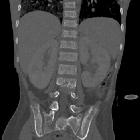leukemia











Leukemia is a hematological neoplasm characterized by the overproduction of immature (blasts) or abnormally differentiated cells of the hematopoietic system in the bone marrow that often, but not always, extends into the peripheral blood.
This article aims to provide an overview of leukemia as an entity and how it is classified. For a further detailed discussion, including radiographic features, please refer to the specific articles on each subtype. Also, for the entire classification of hematological neoplasms, please refer to the article on "WHO classification of tumors of hematopoietic and lymphoid tissues".
General classification
Leukemia is classically divided according to the percentage of blasts in the bone marrow or peripheral blood:
- acute: when there is a proliferation of mostly immature/poorly differentiated cells (blasts) in the bone marrow (exceeding 20% of the bone marrow cell population)
- clonal cells buildup crowds out the marrow in detriment of healthy blood lineage cells
- disease becomes symptomatic early
- chronic: when there is a proliferation of mostly mature but abnormal leukocytes (abnormal leukocytosis) with or without associated cytopenia
Specific classification
The 2016 revised WHO classification has an extensive list of subtypes of leukemia, this article will list the most prevalent ones .
- acute lymphoblastic leukemia (ALL)
- commonly affecting children (~80% of leukaemias in this group)
- usually severely symptomatic
- chronic lymphocytic leukemia (CLL)
- commonly affecting elderly patients (mainly over 75 years)
- acute myeloid leukemia (AML)
- commonly seen in adults, but is also the second most common form affecting children
- male predominance
- chronic myeloid leukemia (CML)
- commonly affecting male adults
- Philadelphia chromosome is present in 90% of cases
Systemic involvement
Siehe auch:
- Akute myeloische Leukämie
- pulmonale Manifestationen der Leukämie
- Akute lymphatische Leukämie (ALL)
- Chronische lymphatische Leukämie
- akute Leukämie
- leukemia of infancy
und weiter:

 Assoziationen und Differentialdiagnosen zu Leukämie:
Assoziationen und Differentialdiagnosen zu Leukämie:
